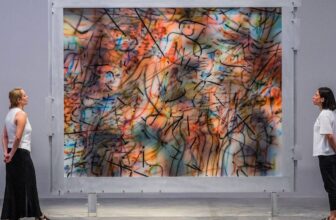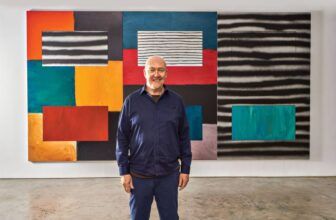Roy Lichtenstein: The Man Who Made Comics into Fine Art
In the pantheon of 20th-century art, few figures stand out as boldly and unmistakably as Roy Lichtenstein. With his comic book characters, bold lines, and Ben-Day dots, Lichtenstein carved out a unique space between popular culture and high art. He was a pioneer who redefined what art could be, taking mass-media images and turning them into icons that now command tens of millions of dollars at international auctions.
But who was Roy Lichtenstein, really? What makes his work so valuable, and what is it about his style that continues to captivate the world decades after his death?
The Early Life of Roy Lichtenstein
Born in New York City on October 27, 1923, Roy Fox Lichtenstein grew up in Manhattan in a wealthy, educated, and culturally inclined family. His early exposure to both science and art shaped his dual interest in structure and creativity. He studied at the Art Students League of New York before enrolling at Ohio State University, where he honed his skills as an artist and teacher. His studies were interrupted by service in the U.S. Army during World War II, but after the war, he resumed his education and eventually became an art professor.
Lichtenstein experimented with various modern art movements, including Cubism and Abstract Expressionism, before discovering the style that would define his career. It wasn’t until the early 1960s that his true breakthrough came, as he turned his gaze to commercial illustrations and comic strips.
What Was Roy Lichtenstein Known For?
Roy Lichtenstein is best known for his role as a leading figure in the Pop Art movement. While Pop Art had various practitioners like Andy Warhol, Claes Oldenburg, and James Rosenquist, Lichtenstein’s work stood out due to his distinct use of comic book imagery, saturated primary colors, and a meticulous technique mimicking commercial printing processes.
His early masterpieces like Whaam! (1963), Drowning Girl (1963), and Look Mickey (1961) shocked the art world. Critics and traditionalists dismissed his work as plagiarism or kitsch, arguing that copying comic books wasn’t “real art.” But that was precisely the point, Lichtenstein was challenging the rigid definitions of what art was supposed to be.
He transformed the mundane into the monumental, elevating disposable culture into a dialogue about consumption, identity, and modern aesthetics.
How Does Roy Lichtenstein Create His Artwork?
Though his art appears effortless, Roy Lichtenstein’s process was highly technical, planned, and deliberate.
He began by selecting an image from comic books, advertisements, or popular media, often dramatically altering the original to suit his artistic vision. He would sketch the image and project it onto a canvas, tracing it meticulously. Then came the most iconic part of his process, the recreation of Ben-Day dots, a printing method used in old comic books to simulate shading and secondary colors.
Rather than simply reproducing these dots, Lichtenstein painstakingly painted them by hand or used stencils, ensuring a uniformity that imitated the mechanical while still retaining his artistic touch. He applied bold outlines, saturated colors (primarily red, yellow, and blue), and flat surfaces to his images, giving them a crisp, vibrant, and almost industrial feel.
Though Lichtenstein’s paintings looked mass-produced, they were anything but. His technique involved hours of detailed work, blending painting with industrial aesthetics.
What Materials Did Roy Lichtenstein Use?
Lichtenstein’s toolset was unconventional for a fine artist at the time. He primarily used:
Oil and Magna (acrylic resin paint) on canvas.
Stencils and hand-painting techniques to create Ben-Day dots.
Commercial-grade canvas to mimic the flat, glossy look of comic book pages.
Screen printing in his later years to achieve precise replication of his style.
He also explored sculpture, ceramics, and murals, always applying his graphic sensibility and bold Pop Art vocabulary across different media.
What Art Style Is Roy Lichtenstein Associated With?
Roy Lichtenstein is indelibly associated with Pop Art, a movement that emerged in the 1950s and 1960s in Britain and the United States. Pop Art focused on mass culture, consumerism, and the everyday, often drawing imagery from advertising, movies, music, and comics.
Within Pop Art, Lichtenstein developed a signature style characterized by:
Comic-strip imagery.
Speech bubbles and dramatic dialogues.
Simplified forms and strong outlines.
Primary color palettes.
Ben-Day dot shading patterns.
However, Lichtenstein wasn’t merely copying comic books. He was engaging in a conceptual dialogue about authorship, originality, and the intersection of fine art and mass culture. In that way, his work has deep roots in both visual aesthetics and postmodern theory.
How Famous Is Roy Lichtenstein?
Roy Lichtenstein is considered one of the most important and widely recognized artists of the 20th century. His work has been displayed in virtually every major museum, including:
The Museum of Modern Art (MoMA) in New York
The Tate Modern in London
The Art Institute of Chicago
The Guggenheim Museum
The National Gallery of Art in Washington, D.C.
His impact is so profound that even people unfamiliar with his name often recognize his work instantly. His stylized women, melodramatic speech bubbles, and warplane explosions have become part of our collective visual culture.
Beyond the art world, Lichtenstein’s influence has spilled into fashion, graphic design, advertising, and music videos, making his work truly global in reach.
What Is Roy Lichtenstein’s Most Famous Artwork?
While Lichtenstein created hundreds of artworks, several stand out as particularly iconic:
Whaam! (1963)
One of his most celebrated works, Whaam! is a large-scale diptych based on a 1962 comic panel from “All American Men of War.” It depicts a fighter plane shooting down an enemy jet, with the onomatopoeic “WHAAM!” exploding across the canvas. It’s held at the Tate Modern in London.Drowning Girl (1963)
This painting shows a woman crying in a turbulent sea, thinking to herself, “I Don’t Care! I’d Rather Sink, Than Call Brad for Help!” The emotional drama, combined with flawless Ben-Day dot technique, makes it one of his masterpieces.Look Mickey (1961)
Often considered the birth of Lichtenstein’s Pop Art style, Look Mickey features Donald Duck and Mickey Mouse. It marked his shift from Abstract Expressionism to commercial imagery.Oh, Jeff…I Love You, Too…But… (1964)
This is one of his most famous depictions of a teary-eyed woman trapped in emotional turmoil, complete with soap-opera dialogue.Brushstrokes series (1965–66)
This series mocked the spontaneity and heroism of Abstract Expressionist brushwork by rendering bold, expressive strokes in his precise, mechanical style.
How Many Artworks Did Roy Lichtenstein Create?
Roy Lichtenstein was an exceptionally prolific artist. Over his career, he created:
More than 5,000 drawings and paintings.
Sculptures, ceramics, and public murals.
A vast number of prints and lithographs, he was a major innovator in printmaking.
His catalogue raisonné, a comprehensive, scholarly listing of all his works, includes thousands of entries, attesting to his enduring dedication to art and innovation. Even after his death in 1997, his estate, exhibitions, and foundations continue to uncover lesser-known pieces and maintain his legacy.
How Much Does Roy Lichtenstein’s Art Cost?
Lichtenstein’s work is not just iconic, it’s extremely valuable. Prices for his original artworks range dramatically depending on size, medium, and provenance:
Smaller drawings or prints can cost between $20,000 to $500,000.
Large paintings and major works regularly sell for millions of dollars.
Some of his most famous works have fetched record-breaking sums:
Masterpiece (1962) sold for $165 million in a private sale in 2017, one of the most expensive paintings ever sold.
Sleeping Girl (1964) sold at Sotheby’s for $44.8 million in 2012.
Ohhh…Alright… (1964) went for $42.6 million at Christie’s in 2010.
These sky-high figures make Lichtenstein one of the most expensive artists in history, alongside names like Picasso, Warhol, and Basquiat.
Legacy of Roy Lichtenstein
Roy Lichtenstein passed away in 1997, but his influence remains stronger than ever. His blend of popular culture, irony, and precise craftsmanship inspired generations of artists, designers, and creators.
He showed the world that fine art didn’t need to be austere or elitist. It could be funny, dramatic, romantic, and even absurd, just like the comic books that inspired him.
In many ways, Lichtenstein’s work paved the way for today’s visually saturated digital culture. The bold lines, irony, and appropriation techniques we see on social media, memes, and contemporary design all carry traces of his DNA.
Roy Lichtenstein was not just an artist, he was a cultural transformer. By blurring the lines between comic books and canvas, between highbrow and lowbrow, he challenged assumptions and expanded the possibilities of art.
Whether you see his work in a museum, a textbook, or referenced in a fashion ad, one thing is clear: Roy Lichtenstein changed the art world forever.
From his meticulous dots to his timeless drama-filled heroines, his work is a brilliant combination of technique, wit, and mass appeal. And in a world where images rule, his vision continues to shine with both pop and purpose.




